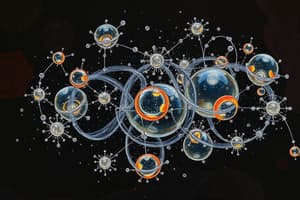Podcast
Questions and Answers
What is the primary difference between ionic and covalent bonding?
What is the primary difference between ionic and covalent bonding?
- Ionic bonding is characterized by a fixed arrangement of bonded atoms, while covalent bonding allows for free movement.
- Ionic bonding involves sharing electrons, while covalent bonding involves transferring electrons.
- Ionic bonding occurs only in metals, while covalent bonding occurs only in non-metals.
- Ionic bonding results in charged ions, whereas covalent bonding results in neutral molecules. (correct)
Which statement accurately describes isotopes?
Which statement accurately describes isotopes?
- Isotopes exhibit different chemical behaviors due to varying electron configurations.
- Isotopes have identical mass numbers but different atomic numbers.
- Isotopes are variations of the same element that differ in the number of protons.
- Isotopes are atoms with the same number of protons but different numbers of neutrons. (correct)
What does the law of conservation of mass imply in a chemical reaction?
What does the law of conservation of mass imply in a chemical reaction?
- The total mass of the reactants must be greater than that of the products.
- Mass can be created or destroyed in exothermic reactions.
- Only non-metal reactions abide by the conservation of mass principle.
- The total mass of reactants is equal to the total mass of products. (correct)
Which of the following is NOT a phase transition?
Which of the following is NOT a phase transition?
What is the role of valence electrons in chemical bonding?
What is the role of valence electrons in chemical bonding?
Which statement accurately describes the relationship between solubility and temperature?
Which statement accurately describes the relationship between solubility and temperature?
What do indicators measure in a solution?
What do indicators measure in a solution?
In stoichiometry, which factor is crucial for performing accurate calculations?
In stoichiometry, which factor is crucial for performing accurate calculations?
What defines the arrangement of elements in the periodic table?
What defines the arrangement of elements in the periodic table?
What distinguishes isomers in organic chemistry?
What distinguishes isomers in organic chemistry?
Flashcards
Atomic Number
Atomic Number
The number of protons in an atom's nucleus.
Ionic Bonding
Ionic Bonding
Atoms transfer electrons to become charged ions, attracted by electrostatic forces.
Chemical Equation
Chemical Equation
A representation of a chemical reaction using symbols and formulas.
States of Matter
States of Matter
Signup and view all the flashcards
Solution
Solution
Signup and view all the flashcards
Concentration
Concentration
Signup and view all the flashcards
Solubility
Solubility
Signup and view all the flashcards
Acids
Acids
Signup and view all the flashcards
Bases
Bases
Signup and view all the flashcards
pH Scale
pH Scale
Signup and view all the flashcards
Study Notes
Atomic Structure and Bonding
- Atoms are the fundamental building blocks of matter, composed of a nucleus containing protons and neutrons, with electrons orbiting the nucleus.
- Protons have a positive charge, neutrons are neutral, and electrons have a negative charge.
- The atomic number is the number of protons in an atom.
- The mass number is the sum of protons and neutrons in an atom.
- Isotopes are atoms of the same element with different numbers of neutrons.
- Electron configuration describes the arrangement of electrons in different energy levels and sublevels around the nucleus.
- Valence electrons are electrons in the outermost energy level, and are involved in chemical bonding.
- Ionic bonding involves the transfer of electrons between atoms, forming ions (positively charged cations and negatively charged anions), which are attracted to each other due to electrostatic forces.
- Covalent bonding involves the sharing of electrons between atoms to form molecules.
Chemical Reactions
- Chemical reactions involve the rearrangement of atoms to form new substances.
- Reactants are the substances that undergo change, and products are the substances formed.
- The law of conservation of mass states that mass is neither created nor destroyed in a chemical reaction.
- Chemical equations represent chemical reactions using chemical formulas to show the reactants and products.
- Balancing a chemical equation ensures that the number of atoms of each element is the same on both sides of the equation.
- Types of chemical reactions include synthesis, decomposition, single displacement, double displacement, and combustion.
- Reaction rates are influenced by factors like temperature, concentration, surface area, and catalysts.
- Activation energy is the minimum energy required for a reaction to occur.
States of Matter
- Matter exists in three primary states: solid, liquid, and gas.
- Solids have a fixed shape and volume, liquids have a definite volume but take the shape of their container, and gases have neither a fixed shape nor volume.
- Phase transitions involve changes between these states (e.g., melting, freezing, vaporization, condensation, sublimation).
- Properties of each state are related to the arrangement and movement of particles.
Solutions
- Solutions are homogeneous mixtures of two or more substances.
- The solute is the substance being dissolved, and the solvent is the substance doing the dissolving.
- Concentration expresses the amount of solute in a given amount of solvent or solution.
- Solubility is the maximum amount of solute that can dissolve in a given amount of solvent at a specific temperature and pressure.
- Factors affecting solubility include temperature, pressure, and the nature of the solute and solvent.
Acids and Bases
- Acids are substances that release hydrogen ions (H+) in an aqueous solution.
- Bases are substances that release hydroxide ions (OH−) in an aqueous solution or accept hydrogen ions.
- The pH scale measures the acidity or basicity of a solution.
- Neutralization reactions occur when acids and bases react to form water and a salt.
- Indicators are substances that change color depending on the pH of a solution.
Stoichiometry
- Stoichiometry is the quantitative relationship between reactants and products in a chemical reaction.
- Mole concept is central to stoichiometric calculations.
- Molar mass is the mass of one mole of a substance.
- Stoichiometric calculations involve using balanced chemical equations to determine the amounts of reactants and products.
Thermodynamics
- Thermodynamics studies energy changes in chemical and physical processes.
- First law of thermodynamics (law of conservation of energy) states that energy cannot be created or destroyed, only transferred or changed from one form to another.
- Second law of thermodynamics states that the total entropy of an isolated system can only increase over time.
- Entropy is a measure of disorder or randomness in a system.
Periodic Table
- The periodic table organizes elements by their atomic number and recurring chemical properties.
- Elements are arranged in periods (rows) and groups (columns).
- Elements in the same group have similar chemical properties due to the similar number of valence electrons.
Organic Chemistry
- Organic chemistry is the study of carbon-containing compounds.
- Carbon forms four covalent bonds, allowing for diverse structures.
- Functional groups are specific groups of atoms within organic molecules that determine their chemical properties.
- Examples of functional groups include hydroxyl, carbonyl, carboxyl, and amino groups.
- Isomers are molecules with the same molecular formula but different structures.
Studying That Suits You
Use AI to generate personalized quizzes and flashcards to suit your learning preferences.




